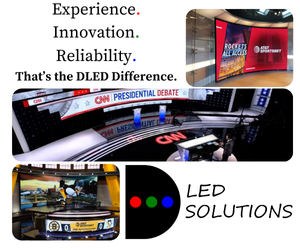Balancing camera robotics with storytelling in broadcast studios

Subscribe to NCS for the latest news, project case studies and product announcements in broadcast technology, creative design and engineering delivered to your inbox.
Broadcast studios are incorporating robotic camera systems into their workflows, aiming to increase operational efficiency and maintain a high standard of creative storytelling.
These systems enable a single operator to manage multiple cameras remotely, reducing staffing needs and improving consistency in camera movements. At the same time, they offer opportunities to create dynamic shots that would be challenging or impossible with manual equipment.
Broadcasters, however, face the challenge of integrating these systems without compromising the narrative focus of their content.
As robotic technology advances, its role in shaping the future of production workflows is expanding, bringing both opportunities and considerations. This transition involves addressing both the advantages and complexities of blending automation with artistic production.
Enhancing production efficiency
Robotic camera systems can create significant improvements in operational efficiency.
“One of the key benefits of cameras is that they improve efficiency and productivity, allowing for faster, more accurate and reliably repeatable program production,” said Neil Gardner, senior product manager for robotics at Vinten.
This efficiency extends to personnel management.
“The main benefit of robotics is minimizing the number of people needed to operate cameras. Now, a single operator can control multiple robots from anywhere in the world,” said Karen Walker, VP of camera motion systems at Ross Video.
“With robotics a single operator can touch a few buttons and create unique on-air looks very quickly,” said Michael Cuomo, VP of Telemetrics.
These systems allow broadcasters to streamline operations, potentially reducing costs and improving studio utilization.
Expanding creative possibilities
While efficiency is crucial, the impact on creative storytelling remains a primary concern for broadcasters. Robotic systems, when implemented effectively, can enhance creative possibilities.
“Over the past seven to eight years a fourth advantage has developed and that’s creating shots that couldn’t be achieved with manual solutions, such as cable suspended flying shots, or ceiling mounted rail movements,” said Paddy Taylor, head of broadcast solutions at MRMC.
“Robotic Camera Control enables a production studio to capture shots they couldn’t get with a manual camera position, like with our TeleGlide ceiling- or floor-mounted track systems,” said Cuomo, emphasizing the creative potential.
These unique camera movements and angles can add visual interest to broadcasts, potentially enhancing viewer engagement.
Despite the advantages, broadcasters must ensure that robotic systems enhance rather than detract from storytelling.
“It’s all about the viewer not being consciously aware of the cameras or their movements. However clever the robotics are or how impressive the graphics and set design, TV news is not entertainment and maintaining that distinction is important for our customers,” said James Eddershaw, managing director of Shotoku Broadcast Systems.
“Camera robotics should enhance storytelling by allowing directors to request specific shots that robotic operators can achieve. Set designers incorporate robotics to complement the storytelling process,” said Walker.
This integration of robotics into the overall production design helps ensure that technology serves the narrative rather than overshadowing it.
Balancing automation and human control
Achieving the right balance between automation and human control is crucial for maintaining creative flexibility.
“Advanced robotic camera systems enhance accessibility, allowing less experienced operators to achieve results similar to veterans of the industry,” Gardner noted.
However, this automation doesn’t necessarily mean eliminating human input.
“A good robotics system will not limit the creative control. The level of overall production automation applied to the robotic (and other) systems may mean that last-minute changes in the production might be more challenging, but that’s a function of the automation constraints not the robotics directly,” said Eddershaw.
Many systems allow for a hybrid approach.
“A well configured robotics system with appropriate balance of automation and human operator override will be prepared for all eventualities,” added Eddershaw.
Adapting to new workflows
The integration of robotic cameras requires adapting existing workflows and potentially redefining roles within production teams.
“Camera robotics enables production teams to take personnel that are performing more mundane tasks and move them into more creative roles,” said Cuomo,
This shift can lead to new opportunities for creativity and skill development. However, it also requires investment in training and potentially reshaping team structures.
“The operation should be carefully managed. One operator can’t control five cameras well if a director is calling for lots of shots, manual cameras have a one-to-one ratio so consider what is realistic,” said Taylor.
As robotic camera technology continues to evolve, it’s likely to further impact broadcast storytelling.
“AI and machine learning will enable robotics cameras and automation to move to the next level. Achieving a natural look at camera movement and framing is key and that comes with experience,” said Gardner.
“Camera robotics combine very well with AR/VR content and the precision of robotics aids the final illusion being created,” said Cuomo.
These advancements suggest that integrating robotic cameras with other emerging technologies could open new avenues for creative storytelling in broadcasting.
Robotic camera systems offer broadcasters clear benefits in efficiency and expanded creative potential. However, their successful implementation requires careful consideration to preserve storytelling quality and adaptability within production teams. Balancing technological advancements with human oversight will be critical as these tools continue to evolve.
Subscribe to NCS for the latest news, project case studies and product announcements in broadcast technology, creative design and engineering delivered to your inbox.








tags
Automation, Broadcast Automation, Broadcast Workflow, James Eddershaw, Karen Walker, Michael Cuomo, MRMC, Neil Gardner, Paddy Taylor, Robotic Camera Control, robotic cameras, Ross Video, Shotoku, Shotoku Broadcast Systems, Telemetrics, Vinten, workflow
categories
Broadcast Equipment, Camera Control & Camera Robotics, Featured, Studio Technology